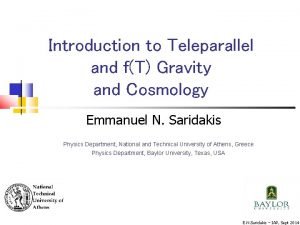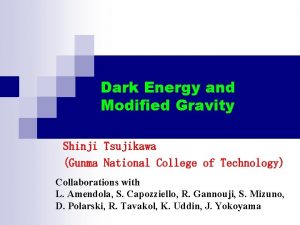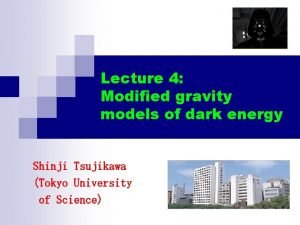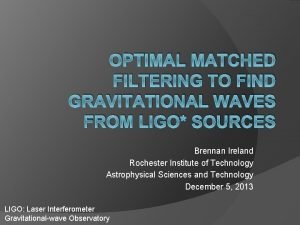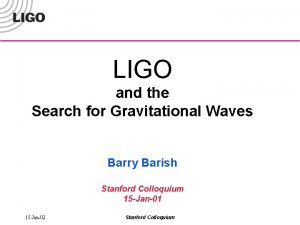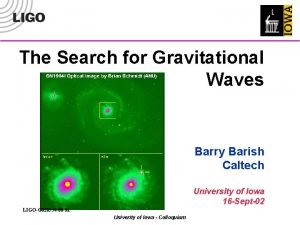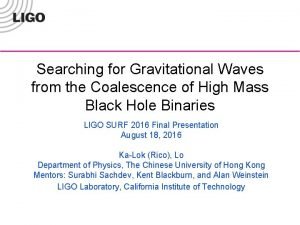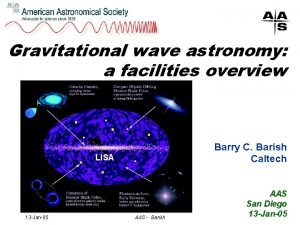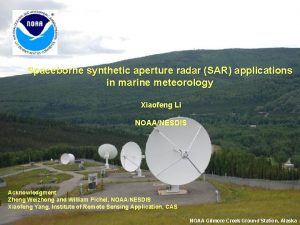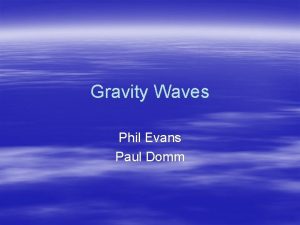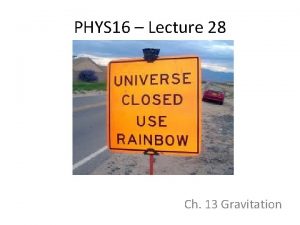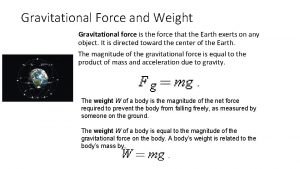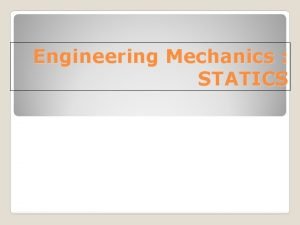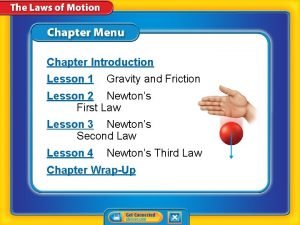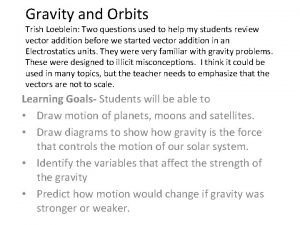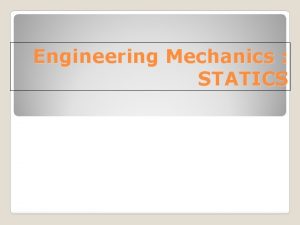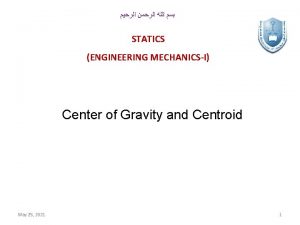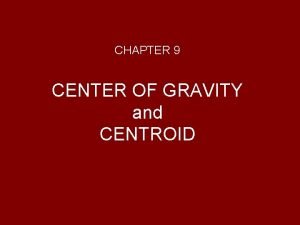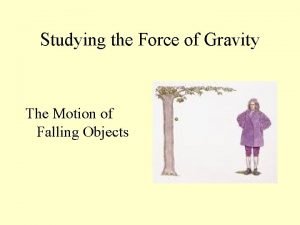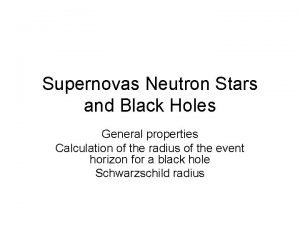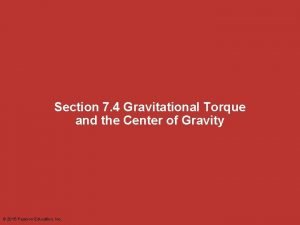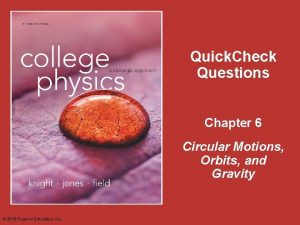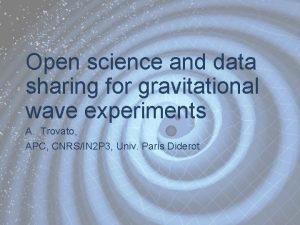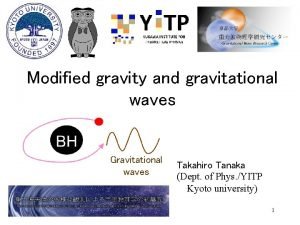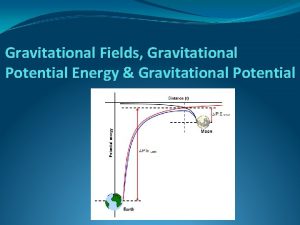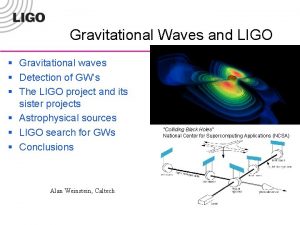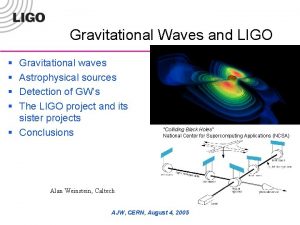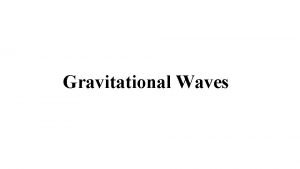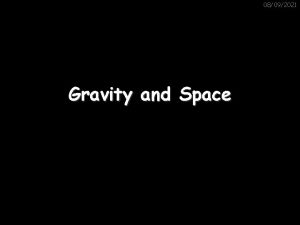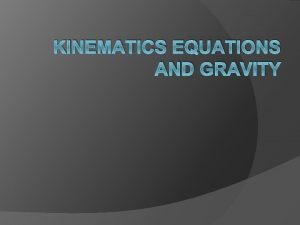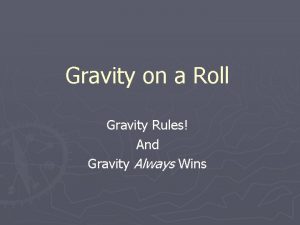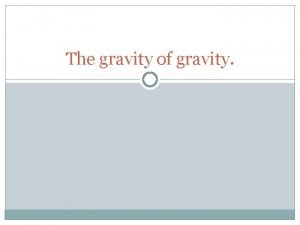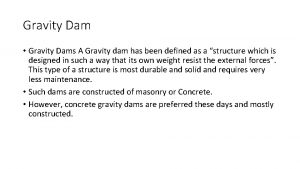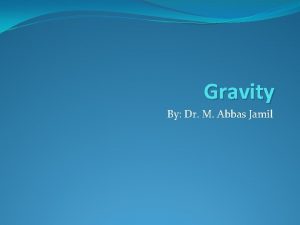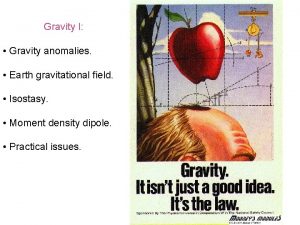Testing Modified gravity and gravitational waves Gravitational waves










































































- Slides: 74

Testing Modified gravity and gravitational waves Gravitational waves Takahiro Tanaka (Dept. of Phys. /YITP Kyoto university) 1

Motivation for modified gravity 1) Incompleteness of General relativity GR is non-renormalizabile Singularity formation after gravitational collapse 2) Dark energy problem 3) To test General relativity GR has been repeatedly tested since its first proposal. The precision of the test is getting higher and higher. ⇒ Do we need to understand what kind of modification is theoretically possible before experimental test? Yes, especially in the era of gravitational wave observation! 2

Gravitation wave detectors e. LISA(NGO) ⇒DECIGO/BBO TAMA 300, CLIO ⇒KAGRA LIGO⇒adv LIGO 3

(Moore, Cole, Berry http: //www. ast. cam. ac. uk/~rhc 26/sources/) 4

Inspiraling-coalescing binaries • Inspiral phase (large separation) (Cutler et al, PRL 70 2984(1993)) Clean system: ~point particles Internal structure of stars is not so important Accurate theoretical prediction of waveform is possible. for detection for parameter extraction(direction, mass, spin, …) for precision test of general relativity l Merging phase Numerical relativity EOS of nuclear matter Electromagnetic counterpart l Ringing tail - quasi-normal oscillation of BH 5

Theoretical prediction of GW waveform Standard post Newtonian approximation ~ (v/c)expansion 4 PN=(v/c)8 computation is ready (Blanchet, Living Rev. Rel. 17: 2 Damour et al. Phys. Rev. D 89 (2014) 064058) Waveform in Fourier space for quasi-circular inspiral 1 PN 1. 5 PN 6

GR is correct in strong gravity regime? Many cycles of gravitational waves from an inspiraling binary 1 cycle phase difference is detectable • Precise determination of orbital parameters • Mapping of the strong gravity region of BH spacetime 7

Typical modification of GR often discussed in the context of test by GWs Scalar-tensor gravity scalar charge: G-dependence of the gravitational binding energy Dipole radiation=-1 PN frequency dependence For binaries composed of similar NSs, 10

Spontaneous scalarization More general model j is canonically normalized EOM Effective potential for a star with radius R. smaller radius larger radius j 2/R 2 8 p. Tf (j) As two NS get closer, “spontaneous scalarization” may happen. Sudden change of structure and starting scalar wave emission. 11 j j

Scalar-tensor gravity (conti) Current constraint on dipole radiation: w. BD> 2. 4× 104 J 1141 -6545 (NS(young pulsar)-WD ) (Bhat et al. ar. Xiv: 0804. 0956) Constraint from future observations: (Yagi & TT, ar. Xiv: 0908. 3283) LISA- 1. 4 M◎NS+1000 M◎BH: w. BD > 5× 103 at 40 Mpc corresponding to DECIGO-1. 4 M◎NS+10 M◎BH: w. BD > 8× 107 collecting 104 events at cosmological distances 12

Scalar-tensor theory BH no hair Turu-turu NS can have a scalar hair Einstein dilaton Gauss-Bonnet, Chern-Simons gravity q ×(higher curvature) • For constnat q, these higher curvature terms are topological invariant. Hence, no effect on EOM. • Higher derivative becomes effective only in strong field.

Hairy BH - bold NS • NS in EDGB and CS do not have any scalar charge. topological invariant, which vanishes on topologically trivial spacetime. • By contrast, BH solutions in EDGB and CS have scalar monopole and dipole, respectively. EDGB: monopole charge dipole radiation (-1 PN order) CS:dipole charge 2 PN order corrections (Yagi, Stein, Yunes, Tanaka (2012))

Observational bounds • EDGB Cassini (Amendola, Charmousis, Davis (2007)) Low mass X-ray binary, A 0620 -00 (Yagi, ar. Xiv: 1204. 4524) Future Ground-based GW observation SNR=20, 6 Msol+12 Msol (Yagi, Stein, Yunes, TT, ar. Xiv: 1110. 5950) • CS Gravity Probe B, LAGEOS (Ali-Haimound, Chen (2011)) Future Ground-based GW observation with favorable spin alignment: 100 Mpc, a~ 0. 4 M (This must be corrected…) (Yagi, Yunes, TT, ar. Xiv: 1208. 5102)

Test of GW generation Pulsar : ideal clock Periastron advance due to GW emission PSR B 1913+16 Hulse-Taylor binary d. Porb/dt=-2. 423× 10 -12 Test of GR by pulsar binaries Agreement with GR prediction (J. M. Weisberg, Nice and J. H. Taylor, ar. Xiv: 1011. 0718) 16

We know that GWs are emitted from binaries. But, then what can be a big surprise when we first detect GWs? Is there any possibility that gravitons disappear during its propagation over a cosmological distance? Just fast propagation of GWs can be realized in Lorentz violating models such as Einstein Æther theory.

Chern-Simons Modified Gravity Right-handed and left-handed gravitational waves are amplified/decreased differently during propagation, depending on the frequencies. (Yunes & Spergel, ar. Xiv: 0810. 5541) The origin of this effect is clear in the effective action. (Flanagan & Kamionkowski, ar. Xiv: 1208. 4871) The time variation of this factor affects the amplitude of GWs.

Current constraint on the evolution of the background scalar field q : : J 0737 -3039(double pulsar, periastron precession) (Ali-Haimoud, (2011) But the model has a ghost for large w, and the variation of GW amplitude is significant only for marginally large w. In other words, modes are in the strong coupling regime, which are outside the validity of effective field theory.

Bi-gravity (De Felice, Nakamura, TT ar. Xiv: 1304. 3920)

Massive gravity Simple graviton mass term is theoretically inconsistent → ghost, instability, etc. Bi-gravity Both massive and massless gravitons exist. → n oscillation-like phenomena? First question is whether or not we can construct a viable cosmological model.

1) Ghost-free bigravity model exists. 2) It has a FLRW background very similar to the GR case at low energy. 3) The non-linear mechanism seems to work to pass the solar system constraints. (Vainshtein mechanism) 4) Two graviton eigen modes are superposition of two metric perturbations, which are mass eigen states at ~ low frequencies and dg themselves at high frequencies. 5) Graviton oscillations occur only at around the crossover frequency, but there is some chance for observation. 22

Ghost free bi-gravity only 5 possible terms including 2 cosmological constants. When g~ is fixed, de Rham-Gabadadze-Tolley massive gravity. Even if g~ is promoted to a dynamical field, the model remains to be free from ghost. (Hassan, Rosen (2012))

FLRW background (Comelli, Crisostomi, Nesti, Pilo (2012)) Generic homogeneous isotropic metrics branch 1 branch 2 branch 1:Pathological: Strong coupling Unstable for the homogeneous anisotropic mode. branch 2:Healthy

Branch 2 background A very simple relation holds: is algebraically determined as a function of r. We consider only the branches with F > 0, F’< 0. required for the absence of Higuchi ghost (Yamashita and TT) We further focus on low energy regime. x → xc for r → 0.

Branch 2 background We expand with respect to dx = x - xc. effective energy density due to mass term Effective gravitational coupling is weaker because of the dilution to the hidden sector. Effective graviton mass natural tuning to coincident light cones (c=1) at low energies (r → 0)!

Solar system constraint: basics v. DVZ discontinuity In GR, this coefficient is 1/2 current bound <10 -5 To cure this discontinuity we go beyond the linear perturbation (Vainshtein) Schematically Correction to the Newton potential F 27

Gravitational potential around a star in the limit c→ 1 Spherically symmetric static configuration: Erasing , , which can be tuned to be extremely large. Then, the Vainshtein radius can be made very large, even if m -1 << 300 Mpc. Solar system constraint: v is excited as in GR.

Excitation of the metric perturbation on the hidden sector: Erasing u, v and R u~ is also suppressed like u. v~ is also excited like v. The metric perturbations are almost conformally related with each other: ~ equivalently u) play the Non-linear terms of u (or role of the source of gravity.

Gravitational wave propagation Short wavelength approximation: (Comelli, Crisostomi, Pilo (2012)) kc mass term is important. Eigenmodes are modified dispersion relation due to the effect of mass C ≠1 is important. k Eigenmodes are modified dispersion relation due to different light cone

At the GW generation, both X Only the first mode is excited and are equally excited. kc k X Only the first mode is detected We can detect only h. Only modes with k~kc picks up the non-trivial dispersion relation of the second mode. Interference between two modes. Graviton oscillations If the effect appears ubiquitously, such models would be already ruled out by other observations.

Summary Gravitational wave observations open up a new window for modified gravity. Even the radical idea of graviton oscillations is not immediately denied. We may find something similar to the case of solar neutrino experiment in near future. Although space GW antenna is advantageous for the gravity test in many respects, more that can be tested by KAGRA will be remaining to be uncovered.

Branch 2 background branch 1 branch 2: branch 2 x becomes a function of r. x → xc for r → 0. effective energy density due to mass term Natural Tuning to c=1 for r → 0. Effective gravitational coupling is weaker because of the dilution to the hidden

Stability of linear perturbation Gradient instability Healthy branch Higuchi ghost JCAP 1406 (2014) 037 De Felice, Gumrukcuoglu, Mukohyama, Tanahashi and TT

Gravitational potential around a star (PTEP 2014 043 E 01 De Felice, Nakamu Spherically symmetric static configuration: Erasing , and truncating at the second order can be tuned to be extremely large. Then, the Vainshtein radius can be made very large, even if m -1 << 300 Mpc. Solar system constraint: Both v and ~v are excited as in GR.

Meaning of A >>1 Gradient instability Healthy branch

Gravitational wave propagation Short wavelength approximation: (Comelli, Crisostomi, Pilo (2012)) kc mass term is important. Eigenmodes are modified dispersion relation due to the effect of mass c ≠1 is important. k Eigenmodes are modified dispersion relation due to different light cone

Gravitational wave propagation over a long distance D Phase shift due to the modified dispersion relation: becomes O(1) after propagation over the horizon distance 1. 0 0. 5 2 - 1 1. 5 - 2 k =0. 2 0. 5 1. 0 - log 10 x k =100 d F 2 d F 1

At the GW generation, both X Only the first mode is excited and are equally excited. kc k X Only the first mode is detected We can detect only h. Only modes with k~kc pick up the non-trivial dispersion relation of the second mode. Graviton oscillations Interference between two modes If the effect appears ubiquitously, the model would be already ruled out.

Gravitational wave oscillations B 4 2 2 - kx 2 =0. 2 kx 2 =100 1 - 1 2 4 - At low frequencies only the first mode is excited. At high frequencies only the first mode is observed. log 10 x B 1 2 B 2 Detectable range of parameters by KAGRA, assuming NS-NS binary at 200 Mpc.

If Vainshtein mechanism works for GW detectors… At the GW generation, both X Only the first mode is excited and are equally excited. kc k Only the first mode is detected X X We detect both and . All modes with k > kc pick up the non-trivial ~ dispersion relation of the second mode. Graviton oscillations Interference between two modes

Solar system constraint: For detection by a. LIGO, a. Virgo and KAGRA: No Vainshtein effect in the inter-galactic space: Window is narrow but open. Bare mass: Gradient instability Cosmologi cal solution disappears

Can Bigravity with large A be naturally realized as a low energy effective theory? Higher dimensional model? ! Matter on right brane couples to h. KK graviton spectrum Only first two modes remain at low energy If the internal space is stabilized However, pinched throat configuration looks quite unstable…

Induced gravity on the branes Dvali-Gabadadze-Porrati model (2000) • Induced gravity terms play the role of potential well. • Lowest KK graviton mass • KK graviton mass Critical length scale ? ? Dy Brane Minkowski Bulk is required to reproduce bigravity. 44

(JCAP 1406 (2014) 004 Yamashita and TT • To construct a viable model, the radion (=brane separation) must be stabilized. • Radions can be made as heavy as KK gravitons. • However, the energy density cannot be made large. Why? We know that self-accelerating branch has a ghost. Normal branch condition: cannot be made larger than in this mod

Deriving bigravity without fine tuning (Yamashita and TT, in preparation) • Despite the fore-mentioned limitation, it would be interesting to see how bigravity derives from brane setup without fine tuning of coupling constants. • We neglect radion stabilization, for simplicity. • Thus, we consider a system of bigravity with radion Gradient expansion We solve the bulk equations of motion for given boundary metrics with the scaling assumptions: KDy <<1 K : bulk extrinsic curvature Dy : Brane separation Krc ~ <1 m 2 ~H 2~ ∂ 2~ l -2~ 1/ rc. Dy

Substituting back the obtained bulk solution into the action, we obtain at the quadratic order in perturbation with This looks very complicated but can be recast into the form of bigravity + radion, which is coupled to the averaged metric:

Why do we have this attractor behavior, c→ 1 and x→xc, at low energies? ? ? KK graviton mass spectrum ~ ~ ~1/d 2 d DGP 2 -brane model? ! d→ 0 potential wells due to induced gravity terms Only first two modes remain at low energy identical light cone

Gravitational wave propagation over a long distance D Phase shift due to the modified dispersion relation: becomes O(1) after propagation over the horizon distance 1. 0 0. 5 2 - 1 1. 5 - 2 k =0. 2 0. 5 1. 0 - log 10 x k =100 d F 2 d F 1

Gravitational wave oscillations 1) At the time of generation of GWs from coalescing binaries, both h and ~h are equally excited. 2) When we detect GWs, we sense h only. B 4 2 2 - 1 - At low frequencies only the first mode is excited. kx 2 =0. 2 kx 2 =100 1 2 4 - B 1 2 B 2 log 10 x At high frequencies only the first mode is observed.

B 4 2 2 - 1 - kx 2 =0. 2 kx 2 =100 1 2 - 2 log 10 x B 1 B 2 4 - Graviton oscillations occur only around the frequency Phase shift is as small as No, x << 1 when the GWs are propagating the inter-galactic low density region. ? 2 - 1. 0 0. 5 1 - log 2 10 x k =0. 2 k =100 1 0. 5 1. 0 1. 5 -

Summary Gravitational wave observations give us a new probe to modified gravity. Even graviton oscillations are not immediately denied, and hence we may find something similar to the case of solar neutrino experiment in near future. Although space GW antenna is advantageous for the gravity test in many respects, we should be able to find more that can be tested by KAGRA.

Parametorized post-Einstein GW waveform for Quasi-circular orbits (Yunes & Pretorius (2009)) Better constraint than pulsar timing for ai>0 or bi>-5/3. corresponding to Newtonian order a Constraints from BH-BH merger b pulsar constraint a (Cornish, Sampson, b. Yunes, Pretorius. (2011)) 12 MOBH-6 MOBH and 18 MOBH-6 MOBH mergers 53

Einstein Æther U is not coupled to matter field directly. with • At the lowest order in the weak field approximation, there is no correction to the metric if Ua // ua (≡the four momentum of the star). • The Lorentz violating effects should be suppressed. two constraints among the four coefficients Compact self-gravitating bodies can have significant scalar charge due to the strong gravity effect. Dipole radiation.

Scalar-tensor gravity (conti) Current constraint on dipole radiation: w. BD> 2. 4× 104 J 1141 -6545 (NS(young pulsar)-WD ) (Bhat et al. ar. Xiv: 0804. 0956) The case of Einstein Æther ⇒ (Yagi et al. ar. Xiv: 1311. 7144) Constraint from future observations: (Yagi & TT, ar. Xiv: 0908. 3283) LISA- 1. 4 M◎NS+1000 M◎BH: w. BD > 5× 103 at 40 Mpc corresponding to Decigo-1. 4 M◎NS+10 M◎BH: w. BD > 8× 107 collecting 104 events at cosmological distances 55

Simple addition of mass to graviton phase velocity of massive graviton Phase shift depending on frequencies Graviton mass effect Constraint from future observations: LISA- 107 M◎BH+106 M◎BH at 3 Gpc: graviton compton wavelength lg > 4 kpc (Yagi & TT, ar. Xiv: 0908. 3283) 56

Prediction of the event rate for binary NS mergers double pulsar NS-WD total coalescence time (Faulkner et al Ap. J 618 L 119 (2005)) Time to spin-down to the current spin velocity + time to elapse before coalescence event rate per Milky way galaxy the volume in which we can detect an observed binary NS when it is placed there. 0. 4~ 400 yr-1 for adv. LIGO/Virgo (Abadie et al. 2010) If short g -ray bursts are binary NS mergers, >1. 5 yr-1 for advanced detector network (Yonetoku et al. 1402. 5463) 57

Gravitation wave detectors 15 16 17 18 19 20 TAMA 300, CLIO ⇒KAGRA 27 28 29 30 21 22 年 i. KAGRA b. KAGRA adv LIGO adv Virgo LIGO India LISA pathfinder DECIGO pathfinder Pre DECIGO e. LISA(NGO) ⇒DECIGO/BBO e. LISA DECIGO LIGO⇒adv LIGO 58

59

Ghost free bi-gravity When g ~is fixed, de Rham-Gabadadze-Tolley massive gravity. No gauge degrees of freedom, but by introducing a field becomes a gauge symmetry. Fixing the gauge by p =0 ⇒ original theory Imposing condition on gmn ⇒ p becomes dynamical

Setting If , we consider flat metric + p perturbation: , its variation gives higher derivative terms. To avoid higher derivatives of p in the EOM,

In other words: 10 (metric components) – 4 (constraints) = 6 Since massive spin 2 field has 5 components, one scalar remains, which becomes a ghost (kinetic term with wrong sign). If constraints do not completely fix the Lagrange multipliers, g 0 m, their consistency relation gives an additional condition. As a result, the residual scalar degree of freedom disappears. (Hassan, Rosen (2011))

EOM of Gravitational waves (Comelli, Crisostomi, Pilo (2012)) Short wavelength approximation: Two propagation speeds are not same for c≠ 1. [≠n –oscillation] Eigen mode decomposition

4 kx 2 =0. 2 kx 2 =100 B 2 - 1 2 - B 1 B 2 2 log 10 x 4 - Graviton oscillations occur only around the frequency Phase shift is as small as No, x << 1 when the GWs are propagating the inter-galactic low density region. 1. 0 ? 0. 5 2 - 1 - log 2 10 x k =0. 2 k =100 1 0. 5 1. 0 1. 5 -

Solar system constraint Ordinary Vainshtein mechanism is not good enough! Ordinary Vainshtain mechanism tells that neglected on small length scales for Then, however, “local effective gravitational coupling ≠ “cosmological one can be simply. ” ” Here, we do not send , but we only tune the graviton mass to be small: “local effective gravitational coupling”= 65

Vainshtein a la brane In the DGP two-brane model stabilized at a small brane separation, this Vainshtein mechanism can be easily understood. Junction conditions: small separation ? ? d Furthermore, d should shrink to maintain stabilization at large energies Nearly identical metrics tightly stabilized brane separation 66

Induced gravity on the brane Dvali-Gabadadze-Porrati model (2000) Critical length scale ? ? y Brane Minkowski Bulk • For r<rc , 4 -D induced gravity term dominates? • Extension is infinite, but 4 -D GR seems to be recovered for r < rc. very different from the other braneworld models 67

Gravitons are trapped to the brane but not completely. 5 D scalar toy model: Source term Solution in the bulk is given by ? ? Brane y Minkowski Bulk 68

Static pointlike source on the brane large scale (small k) five dimensional behavior small scale (small k) four dimensional behavior After propagation over cosmological distance, GWs may escape into the bulk? 69


(taken from Esposito-Farese, gr-qc/0402007) 71

(taken from Esposito-Farese, gr-qc/0402007) 72

73

estimated merger event rate (Gair et al, CQG 21 S 1595 (2004) ) LISA detectable event rate 74

Probably clean system • Interaction with accretion disk (Narayan, Ap. J, 536, 663 (2000)) , assuming almost spherical accretion (ADAF) Frequency shift due to interaction Change in number of cycles obs. period ~1 yr 75

Black hole perturbation ² M≫m ² v/c can be O(1) Gravitational waves Linear perturbation : master equation Regge-Wheeler formalism (Schwarzschild) Teukolsky formalism (Kerr) Mano-Takasugi-Suzuki’s method (systematic PN expansion) 76
 Gravity for dummies and dummies for gravity equations
Gravity for dummies and dummies for gravity equations F(t) gravity
F(t) gravity Modified gravity
Modified gravity Modified gravity
Modified gravity Matched filtering gravitational waves
Matched filtering gravitational waves Gravitational waves
Gravitational waves Gravitational waves
Gravitational waves Gravitational waves
Gravitational waves Gravitational waves
Gravitational waves Compare and contrast p waves and s waves using venn diagram
Compare and contrast p waves and s waves using venn diagram Atmospheric gravity waves
Atmospheric gravity waves Forceparcel
Forceparcel Mechanical waves and electromagnetic waves similarities
Mechanical waves and electromagnetic waves similarities Mechanical waves characteristics
Mechanical waves characteristics Mechanical waves and electromagnetic waves
Mechanical waves and electromagnetic waves What is a semiconductor used for
What is a semiconductor used for Difference between matter waves and electromagnetic waves
Difference between matter waves and electromagnetic waves Mechanical waves and electromagnetic waves similarities
Mechanical waves and electromagnetic waves similarities Seismic waves
Seismic waves Mechanical wave and electromagnetic wave
Mechanical wave and electromagnetic wave Constructive
Constructive Positive testing and negative testing
Positive testing and negative testing Cs3250
Cs3250 Light is electromagnetic radiation true or false
Light is electromagnetic radiation true or false What type of waves are sound waves? *
What type of waves are sound waves? * Is echolocation transverse or longitudinal
Is echolocation transverse or longitudinal Mechanical waves vs electromagnetic waves
Mechanical waves vs electromagnetic waves Is a seismic wave mechanical or electromagnetic
Is a seismic wave mechanical or electromagnetic What is domain testing
What is domain testing Motivational overview in software testing
Motivational overview in software testing Data flow testing strategies in software testing
Data flow testing strategies in software testing Anuj magazine
Anuj magazine Functional testing vs unit testing
Functional testing vs unit testing What is testing
What is testing Control structure testing in software engineering
Control structure testing in software engineering Decision table testing in software testing
Decision table testing in software testing Decision table testing example
Decision table testing example Apa yang dimaksud dengan black box testing
Apa yang dimaksud dengan black box testing Behavior testing adalah
Behavior testing adalah Decision table for triangle problem
Decision table for triangle problem Rigorous testing in software testing
Rigorous testing in software testing Testing blindness in software testing
Testing blindness in software testing Component testing is a black box testing
Component testing is a black box testing Domain testing in software testing
Domain testing in software testing How can mechanical energy be conserved
How can mechanical energy be conserved Centripetal force and gravitational force
Centripetal force and gravitational force Normal force and gravitational force
Normal force and gravitational force Gravity and friction
Gravity and friction Gravity and inertia study jams
Gravity and inertia study jams Centroid in engineering mechanics
Centroid in engineering mechanics Define specific gravity in fluid mechanics
Define specific gravity in fluid mechanics Rotational motion and the law of gravity
Rotational motion and the law of gravity Jackfruit maturity indices
Jackfruit maturity indices How are weight and gravity related
How are weight and gravity related Determine the cg of the section above.
Determine the cg of the section above. Specific gravity units g/ml
Specific gravity units g/ml Plummet method specific gravity
Plummet method specific gravity Friction can act between two unmoving, touching surfaces.
Friction can act between two unmoving, touching surfaces. Centroid of composite shapes
Centroid of composite shapes Phet gravity and orbits
Phet gravity and orbits Centroid mechanics
Centroid mechanics Air resistance and gravity
Air resistance and gravity Study jams gravity
Study jams gravity Static mechanics
Static mechanics Physics 02-02 weight and gravity answers
Physics 02-02 weight and gravity answers Centroids and centers of gravity
Centroids and centers of gravity Lesson 4 gravity and motion lesson review
Lesson 4 gravity and motion lesson review Gravitational force
Gravitational force Slip casting advantages and disadvantages
Slip casting advantages and disadvantages Inertia and gravity
Inertia and gravity What are the 4 universal forces
What are the 4 universal forces Escape velocity of neutron star
Escape velocity of neutron star Gravitational torque formula
Gravitational torque formula Gravitational force quick check
Gravitational force quick check Gravitational wave open science center
Gravitational wave open science center

